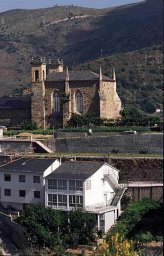Castilla y León
Historic cities
Gothic cathedral of Burgos
Defiant castles
Distances between sights can be daunting in the country’s largest region, but five historic cities reward the intrepid visitor: the harmonious Renaissance university city of Salamanca; Segovia with its towering Roman aqueduct and exquisite royal castle; Burgos built around a Gothic cathedral; León, its cathedral famous for its stained-glass windows; and Ávila, ringed by medieval walls. En route between these cities there are vast empty tracts of land but you are rarely out of sight of a castle, a distinguishing feature of this part of Spain.
Detail, Salamanca University
Ávila
Ávila was founded in the 11th century and remains famous today for the surrounding wall and 87 towers. Of the nine gates allowing passage through the ramparts, the Saint Vincent gate is the most impressive. The fortified city is also celebrated for being the birthplace of Teresa of Avila, an important figure in religious history.
Alcazar of Segovia
The Alcázar of Segovia is a fortress dating from the period of Arab rule and is located in the region of Castile and León, central Spain. The Alcázar was a royal residence, military academy and state prison. It is considered a monument of national historic and artistic interest and was the inspiration for the castles designed by Walt Disney. There are numerous secret passages in the palace that lead to the river below.
Built upon a granite rock in Segovia, Spain, the Alcazar (or imperial palace) is one of the most famous castles in Spain for its romantic, fairy-tale setting.
Located in the Guadarrama Mountains above the confluence of the Esrema and Clamores rivers, its unique mix of architectural and interior design styles include an Islamic-style ceiling, Moorish gardens, and Romanesque turrets and spiral towers.
Las Medulas
Las Medulas are located in Bierzo, northwest of the Aquilanos mountains in the Spanish province of León. They offer a fantastic landscape with reddish relief. The Romans once dug a gold mine there, causing the strange forms of the landscape. The area has now been declared a UNESCO World Heritage site.




